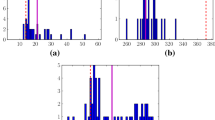Abstract
Recent publications on the design of liner shipping networks are limited in their treatment of the level of service (LoS) experienced by shippers. We propose the use of inventory holding costs—a function of merchandise transit time—as a proxy for LoS. We assume the existence of a two-tier optimization model, where fleet deployment, vessel routing, and vessel speed are determined in the higher tier. Merchandise flows and transshipment quantities are determined in the lower tier. We partition the total merchandise transit time into time spent in open waters, time spent during port calls, and time spent dwelling in the terminal yard. Using the notions of service frequency and service phase, we develop mathematical expressions for the three aforementioned quantities within the lower tier of the optimization model. We arrive at a bilinear expression for overall inventory holding costs that is suitable for liner shipping network design.



Similar content being viewed by others
References
Agarwal R and Ergun O (2008). Ship scheduling and network design for cargo routing in liner shipping. Transport Sci 42: 175–196.
Álvarez JF (2009). Joint routing and deployment of a fleet of container vessels. Marit Econ Logist 11: 186–208.
Christiansen M, Fagerholt K and Ronen D (2004). Ship routing and scheduling: Status and perspectives. Transport Sci 38: 1–18.
Christiansen M, Fagerholt K, Nygreen B and Ronen D (2007). Maritime transportation. In: Barnhart C and Laporte G (eds). Handbooks in OR & MS. Vol. 14, Elsevier BV: Amsterdam, The Netherlands, pp 189–284.
Notteboom TE (2006). The time factor in liner shipping services. Marit Econ Logist 6: 19–39.
Ronen D (2011). The effect of oil price on containership speed and fleet size. J Opl Res Soc 62: 211–216.
Slack B, Comtois C and Sletmo G (1996). Shipping lines as agents of change in the port industry. Marit Pol Mngt 23: 289–300.
Acknowledgements
The author thanks L.B. Reinhardt, D. Pisinger, B. Løfstedt, C. Plum, E. Boutsianis, and two anonymous referees for providing valuable suggestions for improving the presentation of the paper. The full responsibility for the content of this paper rests with the author.
Author information
Authors and Affiliations
Corresponding author
Appendix
Appendix
Theorem 1
-
For two relatively prime service inter-arrival frequencies ζ r , ζ s ∈ℤ+, and for every dwell interval k∈{0, 1, 2, …(ζ s −1)}, there exists an arrival q∈{0, 1, 2, …(ζ s −1)} of a vessel in service r at time t=q·ζ r such that the earliest subsequent arrival in service s occurs k units of time later.
Proof
-
We denote by k q the dwell interval of the merchandise arriving in the qth call of service r. We have established that k q =⌈q·ζ r /ζ s ⌉·ζ s −q·ζ r . Given that a vessel in service s arrives every ζ s units of time, we must have 0⩽k q ⩽ζ s −1 for any q. Given that the k q can take only ζ s integer values, we only need to show that the k q are different for each of the ζ s values of q in {0, 1, 2…(ζ s −1)}.
In order to derive a contradiction, assume k q =k q′, with q≠q′. We would then have



However, ζ s and ζ r are relatively prime, and ζ s does not divide (q−q′). We then have a contradiction, as the right-hand side of (22) is not integral.
This demonstrates that all the k q are different for q∈{0, 1, 2…(ζ s −1)}. □
Corollary 1
-
For any two service inter-arrival frequencies ζ r , ζ s ∈ℤ+, and for every dwell interval k∈{0, 1·μ rs , 2·μ rs …(ζ s /μ rs −1)·μ rs }, there exists an arrival q∈{0, 1, 2…γ rs /ζ r −1} of a vessel in service r at time t=q·ζ r such that the earliest subsequent arrival in service s occurs k units of time later.
Proof
-
We can compress the time dimension by μ rs =gcd (ζ r , ζ s ), which does not alter the correspondence between vessels. We then apply Theorem 1 with ζ r /μ rs and ζ s /μ rs . □
Rights and permissions
About this article
Cite this article
Álvarez, J. Mathematical expressions for the transit time of merchandise through a liner shipping network. J Oper Res Soc 63, 709–714 (2012). https://doi.org/10.1057/jors.2011.72
Received:
Accepted:
Published:
Issue Date:
DOI: https://doi.org/10.1057/jors.2011.72




